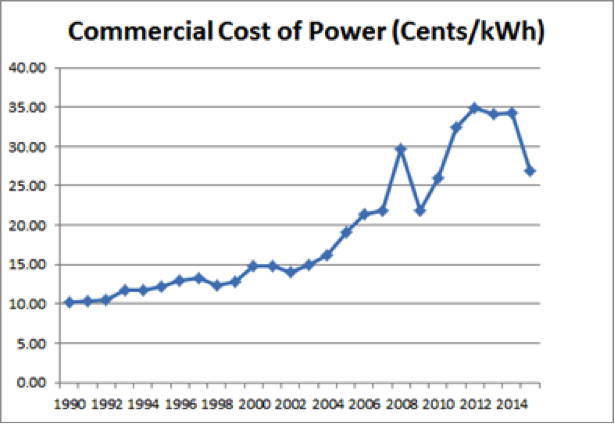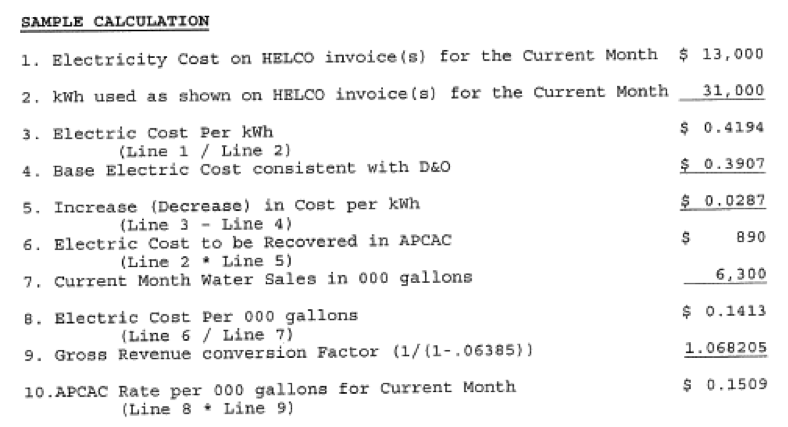For water and sewer utilities regulated by a state’s public utilities commission (PUC), mounting a rate case can be an expensive proposition. In fact, for some particularly small utilities, mounting a rate case can be more expensive than operating the utility for many months. It’s no wonder, therefore, that utilities may be reluctant to undertake rate cases on a regular basis. Some utilities may even wait longer than a decade between rate increases, a decision that may preserve short-term fiscal health, but can be costly in the long term.
The unpredictability of future costs makes it difficult to design new rate structures in preparation for a rate case. In my study at the EFC of rate structures across four different states, I’ve found four, region-specific challenges utilities may confront that lead to financial instability. These are declining water sales due to reduced demand and conservation measures, volatility in the price of power, drought stressors, and environmental and health regulations. The challenge in a rate case, therefore, is, how can the utility commission ensure the cost of service is fair to the consumer and that rates allow the utility to remain fiscally healthy? The three strategies discussed below can help utilities remain fiscally stable while avoiding constantly mounting rate cases by designing rate structures that adjust for uncertainty in future conditions.
Automatic Power Cost Adjustment
For Hawaii and US island territories, unpredictability in the cost of energy is a major challenge. Many of these utilities rely on fuel oil, propane, or natural gas for power, most or all of which must be imported (in raw or refined form) from off-island, which is expensive. Below is a graph of the commercial cost of power for Hawaii from the years 1990-2015:

Source: U.S. Energy Information Administration
Despite two periods of price decreases, the general trend has been an increase in the cost of commercial power in Hawaii, and this increase has been quite rapid at times.
Some water utilities on the six main islands in Hawaii have implemented Automatic Power Cost Adjustment (APCA) clauses that calculate an additional volumetric charge based on the cost of power. This structure has been implemented by both PUC-regulated utilities and non-PUC-regulated utilities. Precedent for power cost adjustments exists in the rate structures of many electricity utilities, like the Tennessee Valley Authority, in the form of fuel cost adjustments. Once a state’s PUC, or a utility’s governing board, approves an APCA, the water utility does not have to have price increases due to the cost of power approved from month to month. Essentially, a utility determines the change in the cost of power in units of dollars per volume of water sold. This increase or decrease in price is then multiplied by a conversion factor and added or subtracted from the volumetric cost of water. A sample APCA is detailed below for a utility in Hawaii:

Because the APCA is based on a single variable (the price of electricity), and this variable cannot be influenced by the water utility themselves, the pricing structure remains objective and fair for both the utility and the consumer. However, utilities can take measures to increase energy efficiency to lower the added cost burden to the customer. Energy savings performance contracting is one such option.
Drought Contingent Pricing
Dry climates and climatic instability can lead to drought and interrupt water supply. This can necessitate that a utility purchase water, as well as potentially increase the cost of treating water withdrawn from depleted reservoirs. Purchasing water, on average, is generally more expensive than withdrawing and treating water.1 While less expensive than purchasing water, treating water from a depleted reservoir increases costs because the remaining water in the depleted reservoir tends to contain higher levels of pollution and requires a more intensive treatment process.
To protect against financial stress during drought, some utilities have implemented drought surcharges, which are implemented when a drought is declared by a third-party organization. For example, the Drought Management Advisory Council has the responsibility of declaring drought and defining the intensity by region in North Carolina. A surcharge may be in the form of a percentage increase in volumetric rates based on the current drought classification. This allows the utility to cover its costs, while promoting conservation measures, without having to mount a rate case during drought.
Other methods of maintaining revenue stability during drought can also be effective. In 2014, the EFC published a report with the Sierra Club Lone Star Chapter in Texas detailing additional revenue stabilization conservation methods.
Environmental Regulations Compliance Cost Adjustment
Finally, while more predictable than drought and power costs, complying with environmental regulations can be an unexpected expense for utilities, although of course these regulations have benefits for consumer health and safety. One Hawaii utility has implemented an Environmental Regulations Compliance Fee Cost Adjustment. For every $600,000, or fraction thereof, in additional costs that this utility incurs due to state or federal environmental regulations, a $0.01 per thousand gallons charge is added to the existing water rate. (This utility, however, is not regulated by the Hawaii Public Utilities Commission.)
As with the two cost adjustments above, this cost adjustment is objective in that it comes into force only when costs increase and is applied in proportion to that increase.
Final Thoughts
Using one or more of these automated rate increase mechanisms reduces the need to make frequent rate changes. Even utilities not regulated by utility commissions that only need to seek approval for rate increases from town or city boards or commissions may benefit from including variables in their rate structures to increase financial stability.
An open question is whether this format of cost adjustment should be allowed for other types of costs. Should costs such as declining water demand be allowed to be included in automated rate change mechanisms? The most effective rate structures will balance between helping utilities easily deal with unexpected costs while also incentivizing them to accurately predict demand and increase operational efficiencies.
1 Environmental Finance Center: Water and wastewater rate surveys in Georgia (page 12), Alabama (page 11), and North Carolina (page 11)
Featured image by Sira Anamwong.

